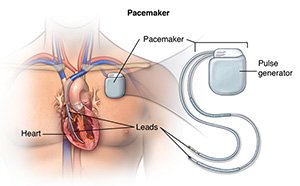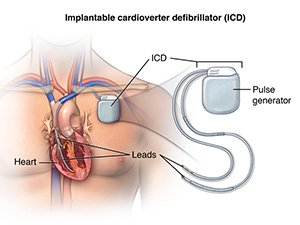Pacemakers and Difibrillators
What is a pacemaker?
A pacemaker is a small device implanted in the chest. It sends electrical signals to start or regulate a slow heartbeat. It’s most often placed in the chest just under the collarbone. A pacemaker may be used if the heart’s natural pacemaker (the SA node) is not working properly causing a slow heart rate or rhythm, or if the electrical pathways are blocked.

Another type of pacemaker is called a biventricular pacemaker. It is used for ventricles that don’t contract at the same time. This can make heart failure worse. A biventricular pacemaker paces both ventricles at the same time. This increases the amount of blood pumped by the heart. This treatment is called cardiac resynchronization therapy (CRT).
What is an implantable cardioverter defibrillator (ICD)?
An implantable cardioverter defibrillator (ICD) looks similar to a pacemaker, though slightly larger. It works very much like a pacemaker. But the ICD can send a low-energy shock that resets an abnormal heartbeat back to a normal. It can also send a high-energy shock if an arrhythmia becomes so severe that the heart can’t pump at all.

Many devices combine a pacemaker and ICD in one unit for people who need both functions. After the shock is delivered, a “back-up” pacing mode is available if needed for a short while.
The ICD has another type of treatment for certain fast rhythms called anti-tachycardia pacing (ATP). This is a fast-pacing impulse sent to correct the rhythm. This can be used instead of shocking the heart in some cases.
For more information on this topic, visit our Health Library.
